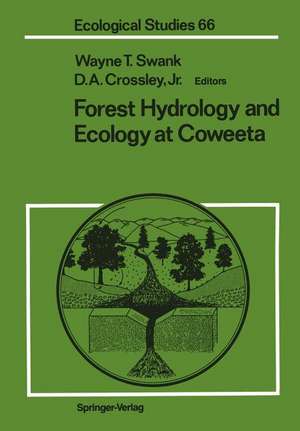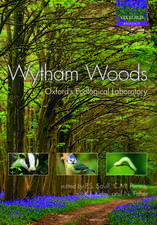Forest Hydrology and Ecology at Coweeta: Ecological Studies, cartea 66
Editat de Wayne T. Swank, D.A., Jr. Crossleyen Limba Engleză Paperback – 27 sep 2011
Din seria Ecological Studies
- 18%
 Preț: 1118.93 lei
Preț: 1118.93 lei -
 Preț: 553.72 lei
Preț: 553.72 lei - 18%
 Preț: 1680.55 lei
Preț: 1680.55 lei - 18%
 Preț: 1003.38 lei
Preț: 1003.38 lei - 20%
 Preț: 1004.71 lei
Preț: 1004.71 lei -
 Preț: 480.62 lei
Preț: 480.62 lei - 5%
 Preț: 752.26 lei
Preț: 752.26 lei - 15%
 Preț: 643.99 lei
Preț: 643.99 lei - 15%
 Preț: 644.18 lei
Preț: 644.18 lei - 15%
 Preț: 652.49 lei
Preț: 652.49 lei - 18%
 Preț: 789.83 lei
Preț: 789.83 lei -
 Preț: 382.36 lei
Preț: 382.36 lei - 15%
 Preț: 643.48 lei
Preț: 643.48 lei - 15%
 Preț: 646.30 lei
Preț: 646.30 lei - 15%
 Preț: 634.32 lei
Preț: 634.32 lei -
 Preț: 384.86 lei
Preț: 384.86 lei - 18%
 Preț: 789.98 lei
Preț: 789.98 lei - 15%
 Preț: 645.14 lei
Preț: 645.14 lei - 15%
 Preț: 649.39 lei
Preț: 649.39 lei - 18%
 Preț: 1005.43 lei
Preț: 1005.43 lei - 18%
 Preț: 949.23 lei
Preț: 949.23 lei - 15%
 Preț: 649.54 lei
Preț: 649.54 lei - 15%
 Preț: 643.34 lei
Preț: 643.34 lei - 15%
 Preț: 649.71 lei
Preț: 649.71 lei - 15%
 Preț: 638.76 lei
Preț: 638.76 lei - 18%
 Preț: 957.62 lei
Preț: 957.62 lei - 18%
 Preț: 1235.25 lei
Preț: 1235.25 lei - 18%
 Preț: 962.18 lei
Preț: 962.18 lei - 18%
 Preț: 949.23 lei
Preț: 949.23 lei - 15%
 Preț: 660.68 lei
Preț: 660.68 lei -
 Preț: 397.76 lei
Preț: 397.76 lei - 15%
 Preț: 638.24 lei
Preț: 638.24 lei - 18%
 Preț: 942.31 lei
Preț: 942.31 lei - 18%
 Preț: 1232.57 lei
Preț: 1232.57 lei - 15%
 Preț: 651.34 lei
Preț: 651.34 lei - 18%
 Preț: 952.72 lei
Preț: 952.72 lei - 18%
 Preț: 1834.27 lei
Preț: 1834.27 lei - 18%
 Preț: 1229.10 lei
Preț: 1229.10 lei -
 Preț: 423.95 lei
Preț: 423.95 lei - 18%
 Preț: 948.92 lei
Preț: 948.92 lei
Preț: 653.14 lei
Preț vechi: 768.40 lei
-15% Nou
Puncte Express: 980
Preț estimativ în valută:
124.100€ • 130.01$ • 103.19£
124.100€ • 130.01$ • 103.19£
Carte tipărită la comandă
Livrare economică 14-28 aprilie
Preluare comenzi: 021 569.72.76
Specificații
ISBN-13: 9781461283249
ISBN-10: 1461283248
Pagini: 488
Ilustrații: XVII, 469 p.
Dimensiuni: 170 x 244 x 26 mm
Greutate: 0.77 kg
Ediția:Softcover reprint of the original 1st ed. 1988
Editura: Springer
Colecția Springer
Seria Ecological Studies
Locul publicării:New York, NY, United States
ISBN-10: 1461283248
Pagini: 488
Ilustrații: XVII, 469 p.
Dimensiuni: 170 x 244 x 26 mm
Greutate: 0.77 kg
Ediția:Softcover reprint of the original 1st ed. 1988
Editura: Springer
Colecția Springer
Seria Ecological Studies
Locul publicării:New York, NY, United States
Public țintă
ResearchCuprins
Section 1 The Coweeta Hydrologie Laboratory.- 1. Introduction and Site Description.- 2. History of Coweeta.- Section 2 Hydrology, Geology, Climate, and Water Chemistry.- 3. Climatology and Hydrology.- 4. Characterization of Baseline Precipitation and Stream Chemistry and Nutrient Budgets for Control Watersheds.- 5. Bedrock Geology and Regional Geologic Setting of Coweeta Hydrologic Laboratory in the Eastern Blue Ridge.- 6. Weathering and Soil-Forming Processes.- 7. Debris Avalanches and the Origin of First-Order Streams.- 8. Streamflow Generation by Variable Source Area.- 9. Research on Interception Losses and Soil Moisture Relationships.- Section 3 Forest Dynamics and Nutrient Cycling.- 10. Forest Communities and Patterns.- 11. Biomass, Primary Production, and Selected Nutrient Budgets for an Undisturbed Hardwood Watershed.- 12. Dynamics of Early Successional Forest Structure and Processes in the Coweeta Basin.- 13. Comparative Physiology of Successional Forest Trees.- Section 4 Canopy Arthropods and Herbivory.- 14. Foliage Consumption and Nutrient Dynamics in Canopy Insects.- 15. Canopy Arthropods and Their Response to Forest Disturbance.- Section 5 Forest Floor Processes.- 16. Changes in Soil Nitrogen Pools and Transformations Following Forest Clearcutting.- 17. Soil Arthropods and Their Role in Decomposition and Mineralization Processes.- 18. Sulfur Pools and Transformations in Litter and Surface Soil of a Hardwood Forest.- Section 6 Stream Biota and Nutrient Dynamics.- 19. Aquatic Invertebrate Research.- 20. The Trophic Significance of Dissolved Organic Carbon in Streams.- 21. Effects of Watershed Disturbance on Stream Seston Characteristics.- Section 7 Man and Management of Forested Watersheds.- 22. Streamflow Changes Associated with Forest Cutting, Species Conversions, and Natural Disturbances.- 23. Forest Access Roads: Design, Maintenance, and Soil Loss.- 24. Effects of Pesticide Applications on Forested Watersheds.- 25. Stream Chemistry Responses to Disturbance.- 26. Acid Precipitation Effects on Forest Processes.- 27. Trace Metals in the Atmosphere, Forest Floor, Soil, and Vegetation.- Section 8 Perspectives on Forest Hydrology and Long-Term Ecological Research.- 28. Forest Ecosystem Stability: Revision of the Resistance-Resilience Model in Relation to Observable Macroscopic Properties of Ecosystems.- 29. European Experiences in Long-Term Forest Hydrology Research.- 30. Past and Future of Ecosystem Research—Contribution of Dedicated Experimental Sites.- References.










